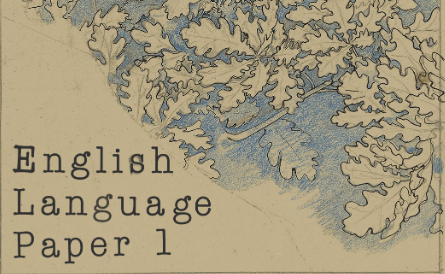Everyone knows how to spot language features, but structural features can be much harder to deal with in English language! A structural feature is anything the writer has done deliberately to shape / organise the text in a way that affects the audience. They are the building blocks or foundations of any piece of writing, and they can occur on a small scale – such as punctuation or word order – or on a larger scale across the whole text – such as a shift in tone, or focus.
For English Literature and Language exam boards such as AQA, OCR, WJEC, CCEA, Eduqas and CAIE (Cambridge), you have to analyse the way in which writers use form and structure to create meaning and effects in their work. For Narrative and Descriptive creative writing questions, you also want to be using these techniques along with language features to get the most out of your work!
This little article will take you through the major structural features you need to know. For more help with creative writing, language analysis and English exams, take our online courses.

If you’re studying AQA, you can take a look at our AQA GCSE Language Paper 1 + AQA GCSE Language Paper 2 – they’re currently on offer as a bundle discount with 25% off the regular price, and a third Language Devices course thrown in for free!
STRUCTURAL FEATURES
OPENINGS, MIDDLES + ENDINGS
Opening — first line or paragraph of the text — is it exciting? If so, how is it? What tone / mood does it set for the story/description? Does it introduce anything important? Why did the writer choose to open the text this way?
Ending / Conclusion — When we read last line or paragraph of the text. What last impressions does it leave us with? What is the final tone/mood/feeling? Are we shocked or surprised by anything?
Focal point — zooming into a particular scene or detail — does the writer focus on anything specific in one of the paragraphs or sections — what do they choose to focus on and why? How does that detail contribute to the story/description as a whole? Why did they want the reader to pay attention to it?
Shift in focus — did the writer shift from one focal point to the next, or did they shift from a wide to a narrow focus? Why did they do this?
Time / Time shifts — What tense(s) does the writer use? Is it past/present/future/conditional, or even more specific if you like — present progressive / imperfect / pluperfect etc). Why did they use a certain tense / why did they change tense at some point?
SYNTAX + SENTENCE STRUCTURE
Punctuation — are there interesting or unusual pieces of punctuation? What is the effect of the specific piece of punctuation? (each piece has different effects so make sure you know them!) How does the punctuation affect the pace of the writing — is it faster or slower and why?
Paragraph length — did the writer use a deliberately long or deliberately short paragraph? Why? How does the structure of that paragraph reflect the meaning?
Sentence length — did the use a deliberately long or deliberately short sentence? Why? How does the structure of that sentence reflect the meaning? Try to analyse sentences in terms of the following: Simple sentences, compound sentences, complex sentences, compound-complex sentences.
Listing — is there a specific point where the writer starts listing something? If so, why do they choose to do it then? A list is compiled of nouns, so you can talk about the effect of grouping nouns together. If possible, you should think about whether it’s syndetic listing (using conjunctions between the nouns — “fish and chips and peas”) or asyndetic listing (no conjunctions between the nouns “fish, chips, peas”). If so, how does that change the pace of the list? Does it create a sense of clutter or panic, or a busy, stressed feeling?
Tripartite structure (rule of 3) — grouping three nouns or phrases together for a clear effect. This technique makes the nouns stand out, and makes them more memorable — why does the writer want us to remember these three details?
Bonus Article: How to Create and Understand ‘Tone’
OTHER STRUCTURAL FEATURES
Point of view / Narrative Perspective — what viewpoint is the story or description told from? (first person, third person limited, third person omniscient) — how does this affect our understanding of the events and plot? Why did the writer choose this perspective?
Flashback — is there a jump in time where we go back to a previous event? If so this does happen, why is it so? How does this change our understanding of the present moment?
Flashforward — is there a jump forward in time? If there is a jump, why and how does this change our understanding of the present moment in the story? Why did the writer make a gap in time there?
Tension — is there a build up and/or release of tension? How does this affect our engagement with the story? How is the tension created through pacing and punctuation?
Mood — what feeling is created in the text — is there a semantic field which shows the mood (a group of words that contribute to one overall impression)? Why did the writer want to set this particular mood and how does it make us feel?
Tone — what is the writer’s attitude towards the subject? Are they serious or sarcastic, positive or negative? How does this affect our experience of the story?
Cyclical structure — is the imagery or story circling back on itself? Is the opening and ending somehow connected? If this happens, why and what does this show about the message behind the story? Does it give a trapped feeling, or a feeling of natural cycles and repetition, or something else?
NEED MORE HELP?
Thanks for reading! If you like this overview of English Language Structural Features – take a look at our complete English revision courses here.
If you’re studying AQA, you can take a look at our AQA GCSE Language Paper 1 + AQA GCSE Language Paper 2 – they’re currently on offer as a bundle discount with 25% off the regular price, and a third Language Devices course thrown in for free!












